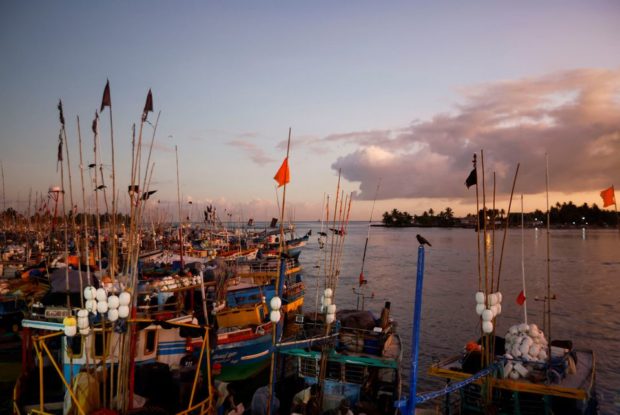
A general view of fishing trawlers parked at Negombo’s “Lellama” fishery harbor during the sunrise, as fishermen and their families struggle due to a lack of diesel and a price hike over the last few months amid the country’s economic crisis, in Negombo, Sri Lanka, April 16, 2022. Picture taken April 16, 2022. REUTERS
NEGOMBO, Sri Lanka — After three weeks at sea, Anton Fernando tallies his sales of tuna and other fish on a dock in Negombo, a fishing town in Sri Lanka, where the country’s financial crisis darkens already murky waters.
The math does not look good for Fernando and his crew of four among the dozen gently bobbing trawlers. Each takes home 40,000 Sri Lankan rupees ($130) from their gruelling expedition.
“This will not be enough to cover their household expenses,” Fernando, 44, told Reuters, holding up a notebook scribbled with numbers. “Even before we go home, we know this isn’t enough to cover electricity and water bills, tuition fees and food.”
The island nation of 22 million people off the southern tip of India is battling its worst financial crisis since independence in 1948, as COVID-19, mismanaged government finances and ill-timed tax cuts sap dwindling foreign reserves.
Last week the central bank said it was suspending repayment on some of its foreign debt pending a restructure.
In the commercial capital Colombo, protesters crowd the streets demanding the ouster of President Gotabaya Rajapaksa as people deal with skyrocketing prices, prolonged power cuts and shortages of medicine, fuel and other items.
In Negombo, the fisherman struggle to stay afloat.
Fishing makes up just 1.3% of the Southeast Asian nation’s economy, but it employs one-tenth of its people and helps feed far more. The island exports tuna, swordfish, crabs, lobsters and prawns to a dozen countries including the United States, Britain, China and Japan, accounting for 8% of its agricultural exports.
Sri Lanka’s fisheries and finance ministries did not immediately respond to emailed requests for comment on measures taken to help the fishing industry.
Some fishermen say they have cut back on food, others have stopped repaying loans. All of those who spoke to Reuters say they constantly scrounge for fuel for their boats and their homes.
‘Focus is to live today’
In Negombo, a tight-knit fishing community 40 km (25 miles) from Colombo, workers pull fish from docked boats, weigh them and pile them into a handful of refrigerated trucks.
Each trip for Fernando’s colourful St. Anne 2 trawler requires at least 1,000 litres (260 gallons) of diesel and several hundred kilograms of ice.
“We have to stand in line for hours to get fuel and even then we are not sure if we will get enough. Ice, bait, nets, everything we need has increased in price,” he said. “Many boats have stopped going out to sea entirely because of the fuel issue.”
Two fishermen with small boats said they siphon petrol from friends’ and neighbours’ motorcycles because fuel stations refuse to fill their jerry cans.
Finance Minister Ali Sabry told Reuters this month the government’s first priority was to restore essentials such as fuel. He said some of the aid the government is seeking from lenders like the International Monetary Fund would go to the country’s economically vulnerable populations.
“Fishermen don’t know how they will get fuel or how they will manage high food costs,” said Herman Kumara, head of the National Fisheries Solidarity Movement that represents some 9,000 fisherman. “Their only focus is to live today.”
The crisis has grounded at least half the area’s trawler fleet, he said, predicting “a life-and-death situation here over the next three to six months”.
Mary Dilani said she makes 1,500 rupees a day drying fish at a nearby beach, while her husband G.K. Chaminda, who borrowed 100,000 rupees three years ago for a small rowing boat and now struggles to repay the loan, makes 2,000 rupees.
“We cannot afford cooking gas anymore,” she said in their small, two-room house by a plastic-strewn beach in Negombo’s Sea Street neighbourhood, where they live with their two daughters and granddaughter. “I have switched to a kerosene stove but sometimes we cannot find kerosene.”
The family’s biggest worry is finding 4,000 rupees for textbooks for a daughter about to start the new school year.
“Life has become very hard,” Dilani said.
($1 = 313.2800 Sri Lankan rupees)
RELATED STORIES